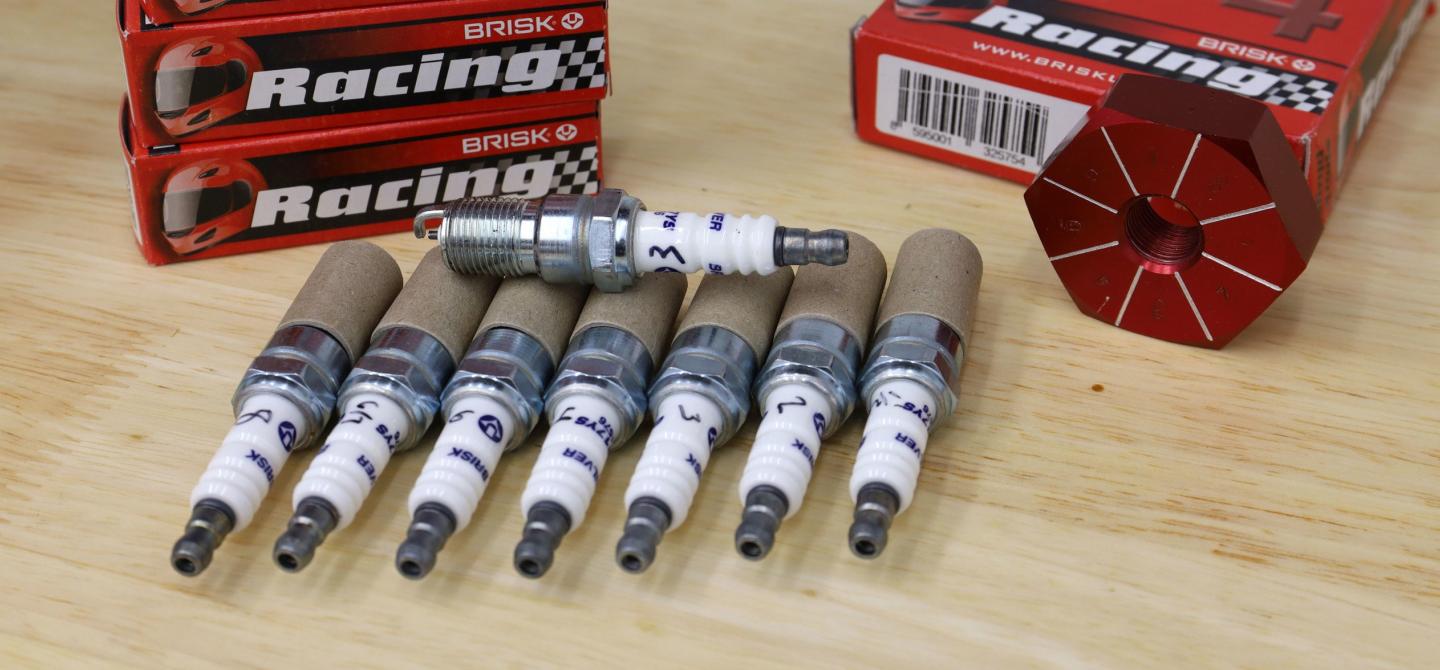We asked and you answered. After a flood of spark plug questions for Brisk USA‘s Bret Lednicky during the comment period, we narrowed them down to the usual ten, with an extra question thrown in for good measure. So read through and gain some knowledge, because Lednicky sure drops a lot in the following answers.
1. Looking at old spark plugs from the Chevy family of engines, The old Champion spark plug with extended tip used to have a heat range available from a cold plug of 9Y all the way to a hot plug 17y. Now I believe they offer only 4 heat ranges. How can this be addressed for those trying to find the correct plug for their application given this narrower offering? Rodney W.
Hello Rodney, most spark plug manufacturers still offer really hot heat ranges of spark plugs, they are becoming more rare though based on the required shell dimensions. Although not ideal for some, upgrading to an aftermarket aluminum cylinder head is a common practice which uses a more common 14mm thread diameter and a 3/4-inch-reach spark plug with a much wider heat range assortment.
2. Assuming a spark plug is in “as new” physical shape, and that the engine is in great mechanical shape, and the A/F is correct and has good oil control, everything is almost perfect. What causes plugs to wear out? What actually happens to them? Rod H.
Hello Rod, different spark plugs have different manners in which they wear out. Copper and silver spark plugs have a tendency to wear down the center electrode, showing physical wear because they are a softer alloy. Iridium / Platinum / Ruthenium spark plugs use materials that do not physically wear out. These spark plugs typically have insulator failure over long periods of time. The insulator is being taxed every time a spark plug fires as its primary job is to contain the electrical charge from the ignition coil to the firing end of the spark plug. If the insulator is compromised, the spark plug will not fire properly.
3. I’m building an iron-headed ’57 Hemi for street use. I’ve added a 6-71 blower, Hilborn 2-7/16 four-port, Vertex magneto, Waterman mechanical fuel pump, Crane roller cam with 286 degrees advertised duration, 8.0:1 compression, 411 cubic inches, gasoline, and I’m hoping for 1,000 horsepower. What is your suggestion for plugs? Henry C.
Hello Henry, to get you the best possible recommendation, we would need to know a bit more about the cylinder head equipped. These pre-1973 iron cylinder heads have a few variations which have different requirements for spark plug dimensions and heat ranges. Generally, the easiest way is to find the casting number on the cylinder heads or to look up the VIN code.
4. I have a 331 SBF in my 1989 Mustang GT with a Vortech V-3 SCi making around 10psi of boost. What spark plugs and gap do you recommend? Wayne G.
Hello Wayne, we would need to know what cylinder heads are equipped. It is pretty common when people stroke their 289/302 to a 331 to swap cylinder heads. If you are still using the factory 302 heads the Brisk Silver Racing HR14YS would be a great choice. If they are aftermarket aluminum heads such as AFR / Trickflow / Edelbrock, etc., the plug dimensions required would change.
5. How do you know what heat range plug that you should use when you build a new engine? David C.
Hello David, great question! Generally, most all OEM engines have a specified heat range from the factory, when modifying the engine to make more power you typically will need to use a colder heat range spark plug. There are quite a few variables when selecting spark plug heat range to consider. Compression ratio, fuel type, application use, forced induction vs naturally aspirated, etc. These are all factors that must be considered when selecting a spark plug heat range. When using aftermarket cylinder heads manufacturers have specified starting heat ranges for their cylinder heads as well.
6. What is the difference between a hot and cold plug? Malcolm N.
Hello Malcolm, different heat range spark plugs have different rates of dispersing or dissipating the heat that is accumulated in the insulator and center electrode. Colder heat range spark plugs are able to remove heat more rapidly. The main difference is in the insulator nose construction. Hotter heat range spark plugs have longer insulator noses, colder heat range spark plugs have shorter insulator noses.
7. I have a 1963 Chevrolet with a stock 283 that is running in one of my budget builds. I am running Champion plugs in the factory heads on regular pump gas. The exterior of the plugs, directly below the porcelain, has turned white. This white substance is similar to flat white paint and does not wipe off.. Any thoughts on what could cause this? Engine runs great, just constantly asked why I have white spark plugs. William M.
Hello William, it sounds like you’re describing some kind of oxidation on the shell body of the spark plug. It could be caused by moisture combined with heat cycles that the plug is going through. If I’m misinterpreting and you are referring to the firing end of the spark plug which is in the cylinder, that would be indicative of a lean condition and the spark plug getting too hot.
8. I am looking for a modern plug to replace the original Champion J-12Y plugs for my slightly modified 289 Studebaker engine that I am putting together. It has a 9.0 compression ratio, a Pertronix ignition system, and I am going to be running a Holley Sniper two-barrel EFI unit. I’m using a factory R-1 camshaft, which I was told is similar to a Chevy 350 HP 327 cam, along with some factory cast headers, any spark plug suggestions would be welcome. Pat G.
Hello Pat, unfortunately, you’re going to be really limited on spark plug design by the factory cylinder head’s dimension requirement. Most all manufacturers that support 3/8-inch reach spark plugs simply offer conventional spark plugs for these engines.
9. What are the differences between plug materials like copper, silver, platinum, and iridium? Do they have performance benefits or is it just a longevity issue? Jeff R.
Hello Jeff, key differences are electrical conductivity, thermal conductivity, melting temperature, and the hardness of the metal. Spark plugs that use silver and copper offer very high electrical and thermal conductivity but they have much lower melting points and are softer alloys causing them to wear out more rapidly. Although they wear more rapidly, because they have superior conductivity, they often offer performance and tuning advantages for high-performance engines especially nitrous and turbo/supercharged engines. Iridium and Platinum are very hard and have very high melting points, this makes them last a long time because they do not physically wear as rapidly making them ideal for OEM replacement where durability is important for consumers. Iridium and Platinum do not offer very good electrical or thermal conductivity though, which can limit high-performance engines in terms of tunability and make the spark plugs more likely to cause pre-ignition in nitrous and forced induction engines.
10. How does plug gap affect performance? My aftermarket ignition says I can open up the gaps to .065 inch, but that seems awfully large. I have a mild street cam in a 306ci small-block Ford. Do I need to be concerned with spark blowout? Troy M.
Hello Troy, spark plug gap is important for the efficiency of the combustion cycle. It is also a balance between the cylinder compression and the ignition system’s capability. If a plug gap is too wide and results in a weak spark discharge you can see a drop in fuel efficiency, as you’ll have unburnt air/fuel mixture. If a spark plug gap is too tight it can have a similar effect because the mixture is not being squeezed tight enough and the spark is being quenched. Just because you can run that wide doesn’t necessarily mean you should. For a naturally aspirated SBF, a reasonable gap with a powerful ignition would be 0.040 to 0.045 inch, max, for the most ideal performance and efficiency.
11. What is the safest way to gap a spark plug? I usually just pry the ground strap open with the gap measuring tool or tap it on the bench to close the gap. A buddy told me I should buy the right tool to close the gap instead of using the bench. Do I really need a special tool to close the gap? Scott H.
Hello Scott, this can be a hot topic depending on who you ask. Our preferred method for opening and closing the gap on a spark plug is to use a pry bar tool that is made for gapping electrodes. It would be hard to describe with words but it is a small pry bar shaped like a T with two notches cut into each side, you slip the ground strap into the notch and you can pry toward you to close the gap or pry away from you to open the gap. This method ensures that you are not putting pressure on the center electrode, ceramic insulator, or the weld on the ground strap. We use a tool similar to a Proto Tools J000K often.






















